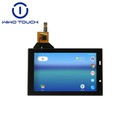Touch screen technology is a new type of human-computer interaction input method, through the finger or other objects to touch the screen to achieve information input and operation. Touch screen is mainly composed of touch detection parts and touch screen controller. The touch detection component is installed in front of the display screen, used to detect the user's touch position and transmit the relevant information to the touch screen controller; the touch screen controller converts the touch information into contact coordinates and transmits them to the CPU, and at the same time receives and executes the commands from the CPU.
According to the different principles of screen surface positioning, touch screen technology can be divided into a variety of types, mainly including resistive, capacitive, acoustic wave (such as surface acoustic wave technology) and infrared. Each technology has its own unique working principle and advantages and disadvantages:
Resistive touch screen: the use of pressure-sensing principle to achieve touch recognition, low cost and long life, but low light transmission and slow reaction speed.
Capacitive touch screen: the use of the human body's electric field induction to achieve touch recognition, with high light transmission, fast response speed and support the advantages of multi-touch, but the cost is higher and weaker anti-interference ability.
Acoustic touch screen: the use of ultrasonic reflection and refraction on the screen to achieve touch recognition, fast response time and long life, but the cost is higher and affected by environmental noise.
Infrared touch screen: the use of infrared on the screen to achieve touch recognition of the barrier, the same response speed and long life, but by the greater impact of ambient light and the need for regular calibration.
HVAC (heating, ventilation and air conditioning) system as an important part of the modern building, its intelligence and convenience demand is increasing. The application of touch screen technology in HVAC systems is promising, mainly in the following aspects:
Intuitive operation: touch screen provides an intuitive and convenient operation interface, and users can directly control the functions of the HVAC system, such as temperature adjustment, air speed setting, mode selection, etc. through the touch screen.
Intelligent control: Combined with the Internet of Things and artificial intelligence technology, the touch screen can realise intelligent control of the HVAC system, automatically adjusting the operating parameters according to the indoor environment, improving energy efficiency and user comfort.
System integration: The touch screen can be used as an integration platform between the HVAC system and other smart home devices, realising the interconnection and unified control of smart devices in the whole house.

Advantages of touch screen application in HVAC
Enhance the user experience: the touch screen interface is intuitive and easy to use, users can easily get started and quickly master the operation skills, enhance the user experience.
Enhance the functionality of the system: the touch screen can be integrated with a variety of functions, such as displaying indoor temperature, humidity and other environmental parameters, providing weather forecasts and other functions, to enhance the practicality and convenience of the system.
Improve energy efficiency: Through intelligent control and system integration, the touch screen can help HVAC systems achieve more accurate energy management, reduce energy waste and improve energy efficiency.
The touch screen excels in performance, mainly in the following aspects:
High transmittance: Capacitive touch screen and other types of touch screen have high transmittance characteristics, which can maintain the clarity and colour reproduction of the display.
High sensitivity: the touch screen can quickly respond to the user's touch operation, to achieve accurate touch positioning and recognition.
Strong durability: the touch screen is made of special materials with anti-scratch and wear-resistant features, and can withstand certain external forces and impacts.
Strong adaptability: the touch screen can adapt to different working environments and temperature conditions, maintaining stable performance and reliability.





